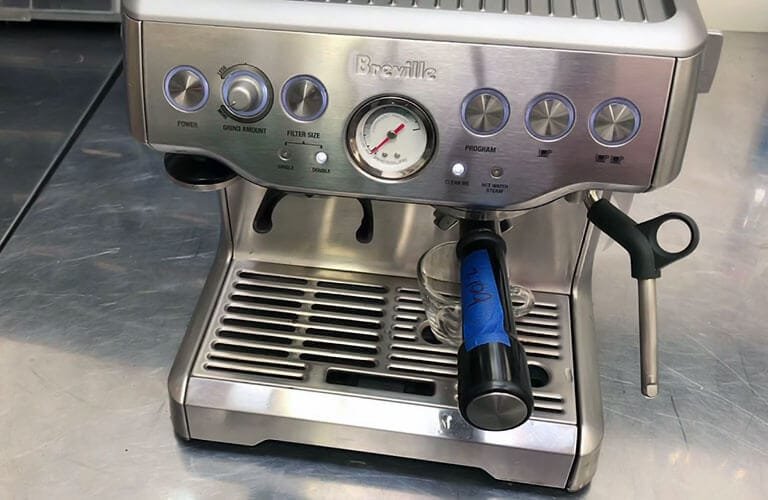The Breville espresso machine pressure gauge may not work due to a blocked filter or a malfunctioning pump. Regular maintenance and troubleshooting can resolve this issue.
Breville espresso machines are renowned for their quality and performance. However, users sometimes encounter issues with the pressure gauge. A malfunctioning pressure gauge can hinder your coffee-making experience. Common causes include a blocked filter, pump issues, or user errors. Regular cleaning and proper usage can often prevent these problems.
Addressing these concerns promptly ensures optimal performance and longevity of your machine. This article provides insights into diagnosing and fixing pressure gauge issues, helping you enjoy a perfect cup of espresso every time.
Introduction To Breville Espresso Machines
Breville Espresso Machines offer a delightful coffee experience. These machines are known for their quality and durability. Breville machines make brewing coffee easy and fun.
Popularity And Reliability
Breville Espresso Machines are popular worldwide. Coffee lovers trust their performance and reliability. These machines are easy to use and maintain. Many people enjoy their consistent coffee flavor.
They come with advanced features. These features enhance the coffee-making experience. Breville machines often have a sleek design. This design fits well in any kitchen.
Common Issues With Pressure Gauges
Sometimes, pressure gauges on Breville machines stop working. This can affect the coffee quality. A faulty gauge can lead to weak or bitter coffee. Here are some common issues:
- Blocked pressure gauge
- Faulty pressure gauge sensor
- Calibration issues
- Wear and tear over time
Identifying these issues helps in maintaining the machine. Regular cleaning and maintenance can prevent many problems. Keep the machine in good condition for the best coffee experience.
Identifying Pressure Gauge Problems
Having issues with your Breville Espresso Machine pressure gauge? It can be frustrating. Identifying the problem is the first step to getting it fixed. Let’s dive into the signs and confirmation steps.
Symptoms Of Malfunction
There are several signs that your pressure gauge might not be working.
- The needle does not move at all.
- The needle moves but shows incorrect pressure.
- The gauge is stuck at a specific point.
- Unusual noises come from the machine.
- Espresso tastes weak or watery.
Confirming The Issue
Once you notice symptoms, you need to confirm the issue.
- Check the machine’s power supply.
- Ensure the water tank is full.
- Inspect the portafilter for blockages.
- Test the machine without coffee grounds.
- Observe the gauge during the test run.
If the gauge needle remains static, it indicates a problem.
Check for any visible damage to the gauge. This can include cracks or leaks.
Safety First: Preparing For The Fix
Before you start fixing your Breville Espresso Machine, think about safety. Safety must come first. Follow these steps to stay safe.
Unplugging The Machine
First, you need to unplug the machine from the power socket. This step is crucial to avoid electric shock. Make sure your hands are dry before you touch the plug.
Here is a simple step-by-step guide:
- Locate the power cord at the back of the machine.
- Gently pull the plug out of the socket.
- Ensure the plug is completely removed.
Always double-check to see if the machine is unplugged.
Allowing The Machine To Cool
After unplugging, let the machine cool down. This is important to avoid burns. The machine parts can stay hot for a while.
Wait at least 30 minutes before touching any parts. To be extra safe, you can wait up to one hour.
| Action | Reason |
|---|---|
| Unplug the machine | Prevent electric shock |
| Wait for the machine to cool | Prevent burns |
Safety is very important. Always take these steps before fixing your espresso machine.
Breville Espresso Machine Pressure Gauge Not Working?[Here is the Basic Troubleshooting Steps]

If your Breville Espresso Machine pressure gauge is not working, don’t worry. Basic troubleshooting can often fix the issue. Follow these simple steps to identify and resolve the problem.
Cleaning The Machine
First, make sure your machine is clean. A dirty machine can cause many problems. Follow these steps to clean your machine:
- Turn off and unplug the machine.
- Remove the water tank and drip tray.
- Clean them with warm soapy water.
- Use a damp cloth to wipe the machine’s exterior.
- Run a cleaning cycle with a descaling solution.
Regular cleaning helps keep the machine in good condition. It can also prevent future issues.
Checking For Obstructions
Check for any obstructions. Obstructions can block the pressure gauge. Here’s what you can do:
- Turn off and unplug the machine.
- Remove the portafilter and check for coffee grounds.
- Clean the portafilter with a brush.
- Inspect the group head for blockages.
- Use a needle to clear any blockages in the group head holes.
Check the steam wand as well. Blockages in the steam wand can affect the pressure gauge. Use a pin to clear any blockages in the steam wand tip.
Following these basic steps can often resolve the issue. If the problem persists, you may need professional help.
Pressure Gauge Specific Fixes
Facing issues with your Breville Espresso Machine pressure gauge can be frustrating. Luckily, there are a few fixes you can try. Below, we’ll cover specific solutions for adjusting the Over Pressure Valve and replacing the pressure gauge.
Adjusting The Over Pressure Valve
If your pressure gauge is not working, check the Over Pressure Valve (OPV). The OPV controls the water pressure in your espresso machine.
Follow these steps to adjust the OPV:
- Turn off and unplug the machine.
- Remove the top cover to access the OPV.
- Locate the OPV adjustment screw.
- Use a screwdriver to turn the screw clockwise to increase pressure.
- Turn the screw counterclockwise to decrease pressure.
- Replace the cover and plug in the machine.
- Test the machine to see if the gauge works.
Replacing The Pressure Gauge
If adjusting the OPV doesn’t help, consider replacing the pressure gauge. This process is straightforward and ensures accurate readings.
Here’s how to replace the pressure gauge:
- Turn off and unplug the machine.
- Remove the top cover to access the pressure gauge.
- Disconnect the gauge from the machine.
- Install the new gauge and secure it in place.
- Replace the top cover and plug in the machine.
- Test the machine to ensure the new gauge is working.
By following these steps, you can resolve common pressure gauge issues. Keep your Breville Espresso Machine in top condition for the best coffee experience.
When To Seek Professional Help
Even the best DIY enthusiasts face limits. Breville espresso machines can be complex. If your pressure gauge stops working, professional help might be needed. Understanding when to make this call can save you time and effort.
Limits Of Diy
Basic maintenance tasks are doable at home. Cleaning parts and descaling the machine are common DIY fixes. Yet, some problems exceed basic troubleshooting.
- Internal wiring issues
- Broken pressure sensors
- Complex electronic faults
Attempting to fix these can worsen the problem. Missteps may void your warranty. If unsure, it’s best to seek professional guidance.
Finding Qualified Technicians
Not all repair services are equal. Ensure you find a qualified technician. Look for certifications and experience with Breville machines.
| Criteria | Why It Matters |
|---|---|
| Certification | Shows formal training and skills |
| Experience | Hands-on knowledge of Breville models |
| Customer Reviews | Trustworthy feedback from other users |
Research local repair shops. Read reviews online. Contact the shop directly. Ask about their experience with Breville espresso machines. This ensures your machine gets the best care.
Preventive Measures For Longevity
Maintaining your Breville espresso machine ensures long-lasting performance. Regular care prevents issues, including the pressure gauge malfunctioning. Follow these preventive measures to keep your machine running smoothly.
Regular Maintenance Tips
- Clean the machine daily: Remove coffee grounds and wipe surfaces.
- Descale monthly: Use a descaling solution to remove mineral build-up.
- Check the water filter: Replace the filter every two months.
- Inspect the steam wand: Ensure it’s free from milk residue.
- Lubricate moving parts: Apply food-safe lubricant to all moving parts.
Avoiding Common Mistakes
- Overfilling the coffee grounds: Use the right amount for each brew.
- Ignoring water quality: Use filtered water to prevent scale build-up.
- Neglecting the steam wand: Clean after each use to avoid clogs.
- Skipping regular maintenance: Follow a strict maintenance schedule.
- Using harsh chemicals: Stick to manufacturer-recommended cleaning agents.
Table Of Key Maintenance Intervals
| Maintenance Task | Frequency |
|---|---|
| Daily Cleaning | Daily |
| Descaling | Monthly |
| Water Filter Replacement | Every 2 months |
| Steam Wand Cleaning | After every use |
| Lubricating Parts | Every 3 months |
Final Thoughts
Understanding why your Breville Espresso Machine Pressure Gauge is not working is vital. A malfunctioning gauge can affect your espresso quality. Addressing this issue promptly ensures your machine operates optimally. Let’s explore the benefits of timely repairs and how it enhances your espresso experience.
Benefits Of Timely Repairs
- Prolongs Machine Life: Regular maintenance prevents further damage.
- Cost-Effective: Early repairs are cheaper than major fixes.
- Consistent Quality: Ensures your espresso tastes great every time.
Enhancing Your Espresso Experience
| Aspect | Benefit |
|---|---|
| Accurate Pressure | Perfect extraction every time. |
| Optimal Flavor | Rich and consistent taste. |
| Confidence | Enjoy making espresso without worry. |
A functioning pressure gauge is essential for a great espresso. It ensures the right pressure during extraction. This results in a delicious and consistent cup of coffee.
Investing in timely repairs can transform your espresso-making experience. It saves money, prolongs machine life, and guarantees quality. Make sure your Breville machine is in top condition for the perfect brew.
Frequently Asked Questions
Why Is My Breville Espresso Machine Gauge Stuck?
The pressure gauge might be stuck due to a blockage or a malfunctioning sensor.
How Do I Fix A Broken Pressure Gauge?
Check for blockages, clean the machine, or replace the gauge if needed.
Can A Clogged Filter Affect The Pressure Gauge?
Yes, a clogged filter can cause inaccurate pressure readings on the gauge.
Is It Safe To Use An Espresso Machine With A Faulty Gauge?
It’s generally safe, but you may not get optimal espresso quality.
How Often Should I Clean My Breville Espresso Machine?
Clean your machine after every use and perform a thorough cleaning monthly.
Conclusion
Fixing a Breville espresso machine pressure gauge can seem challenging. With the right steps, it’s manageable. Regular maintenance and troubleshooting can prevent future issues. Enjoy a perfect cup of espresso every time. Keep your machine in top condition for the best results.
Happy brewing!
